 |
 |
1960 Morgan Drophead Coupé Mark Hershoren foreignaffairsdesk@vclassics.com
Too right you'd be, since it is a Morgan. What's it doing here? In the previous On Your Marques feature, we mentioned in passing that not only did certain automobile manufacturers specify a Volvo engine, but also that private parties used them in cars such as MG TDs and the like when the original engines no longer made the grade. In some cases, the choice may have had a purely economic reason, while in others, the Volvo was chosen for its durability. Another reason, perhaps rarely considered, has largely to do with human health and well-being. Bob Shaw is well known in circles where fine car collectors congregate. He can regularly be found at such prestigious shows as the Pebble Beach Concours d'Elegance and the Midwest's premier show event, the Meadow Brook Concours d'Elegance held in Rochester, Michigan. Suffering a stroke several years ago and losing function in his left arm did not rob him of his enthusiasm for the hobby, but it did make it nearly impossible for him to shift gears or steer the automobiles he enjoyed. Not accepting that the old cars would have to be given up, he sought a solution to his dilemma and took his problem to David Draper. In a previous career, Draper was at least partially responsible for the re-emergence of the convertible in the early 1980s. He is credited with designing and building the Ford Mustang and Chrysler LeBaron convertibles which led the return of the drop-top fashion in the U.S. A company he co-founded, called Cars & Concepts, contracted to perform the conversions. Nowadays, Draper is the owner of a firm in Charlevoix, Michigan, called Time Machines Unlimited.
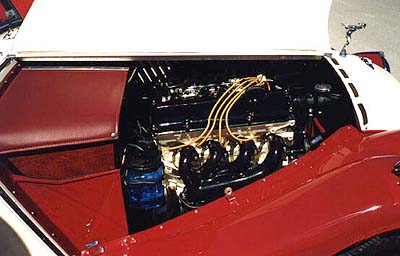 Shaw and Draper set an objective: take an automobile from Shaw's collection and modify it in such a way that it appears relatively original, but is easy to steer and shifts for itself. Actually, Shaw had always wanted an old Bentley. He had a desire for the essence of the style, the luxury of the leather and wood trim, the panache so easily attached to English motorcars from the middle of this century. Shaw's stable was viewed for a suitable candidate for the transformation and one was found; the final choice was a 1960 Morgan drop-head coupé. While Morgans are scarce enough, a drop-head coupé is even more so. A bit more posh than the more numerous roadsters and possessing a full top, they also had full doors as opposed to the roadster's cut-down ones. More or less unchanged since the originals appeared in the mid-1930s, Morgan had envisioned their cars as sport cars particularly. The touring car concept was eschewed by the Morgan Company, but this is just what the Shaw Morgan has been pleasingly transformed into.
Draper and his staff did research with a mind to find the narrowest automatic transmission readily available for a rear wheel drive car. The trans tunnel in fact, the whole body of the Morgan is quite narrow. The decision to use a European Borg-Warner box was agreed upon and one was found in a 1982 Volvo 240-series car. At one point in the pondering, attaching the B-W trans to the original Triumph power plant was considered. Modifications to the transmission tunnel made room for the automatic, and brackets were fabricated for it and its companion engine by Time Machines Unlimited's Gregory Henderson while Tom Buerkle readied the power unit for its new home. Meanwhile, in another part of the shop, John Wagner was transforming supple leather hides from Connolly Brothers into skins to cover the seats and trim the interior. Owner Shaw's other passion for old wooden speed boats was seized by these auto-wizards and reflected in the form of the mahogany trim on the doors, dashboard, and in the bows and supports of the convertible top. That the wood in its glossy finish is there is enough; meticulous inlays make it almost too much to bear. Almost.
Lifting the bonnet will reward you with a view of a somewhat unusual-appearing OHC Volvo engine. Coatings and paints, used without regret or reserve, abound. On the passenger side, a black ceramic coated exhaust manifold dominates the view and fools the casually interested into seeing what appears to "belong." All components are either painted, plated, coated or upholstered. Yes, upholstered. The tool tray that was standard equipment on the top of the foot well on the original car has been expanded and capped with a padded, leather-covered lid. While the exterior appears to be stove-bolt stock, the side and tail lamps were adapted from their original intended use after being found at the famed Retromobile in France. The side strakes were designed, machined and highly polished at the Time Machines shop. Finished in a deep red with cream, the classic two- tone paint scheme serves as icing on a torte that promises surprise and delight on the sampling.
Easy-print version of this article |
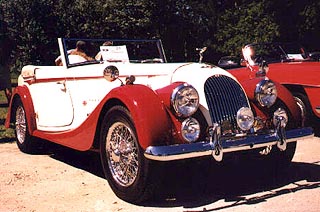
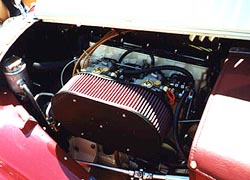 Reasoning that the B21 engine was well matched to the automatic it served, the decision was made to supercede the Triumph with the Volvo. An added benefit to this choice: the trouble of coordinating the use of both Whitworth and Metric fasteners was eliminated. Curious perhaps, but a Volvo engine was employed merely because it was attached to the transmission of the desired dimensions!
Reasoning that the B21 engine was well matched to the automatic it served, the decision was made to supercede the Triumph with the Volvo. An added benefit to this choice: the trouble of coordinating the use of both Whitworth and Metric fasteners was eliminated. Curious perhaps, but a Volvo engine was employed merely because it was attached to the transmission of the desired dimensions!
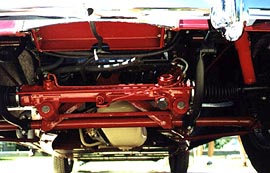 Following the manifold down to the head pipe, one sees it modified to follow the original route of the exhaust as Morgan intended. From the left side, you'll be greeted with the sight of Weber side-draft carburetors. Artfully squeezed in is the power steering pump which powers the Ford Mustang rack and pinion unit. An oil cooler is situated in front of the radiator. Despite being more amply equipped than a stock Morgan, everything looks quite comfortable. It could've been rather more cramped, but the possible inclusion of air conditioning was ruled out.
Following the manifold down to the head pipe, one sees it modified to follow the original route of the exhaust as Morgan intended. From the left side, you'll be greeted with the sight of Weber side-draft carburetors. Artfully squeezed in is the power steering pump which powers the Ford Mustang rack and pinion unit. An oil cooler is situated in front of the radiator. Despite being more amply equipped than a stock Morgan, everything looks quite comfortable. It could've been rather more cramped, but the possible inclusion of air conditioning was ruled out.
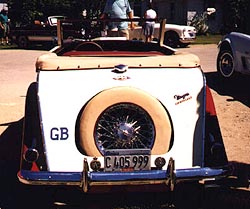 In just nine short months, through Shaw's inspiration, along with the innovation and effort of the gentleman at Time Machines Unlimited and the installation of a humble Volvo power-train, the 1960 Morgan went from a nice old car its owner could not use to a stunning historic Grand Touring automobile.
In just nine short months, through Shaw's inspiration, along with the innovation and effort of the gentleman at Time Machines Unlimited and the installation of a humble Volvo power-train, the 1960 Morgan went from a nice old car its owner could not use to a stunning historic Grand Touring automobile.